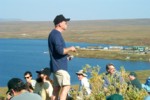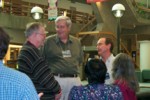Twenty-three sites were represented at the fall 2004 Coordinating Committee meeting held in Fairbanks and Toolik Lake, Alaska from August 16-22. The meeting began with an Executive Committee session followed the next day by a science theme workshop on the interactions of disturbance and climate change that was organized by Terry Chapin. The main session of the CC meeting took place at the University of Alaska Fairbanks on Thursday August 19th, and was followed by a two-pronged field trip to the Bonanza Creek field sites. The group then traveled by bus to Toolik Lake for the second half of the meeting and concluded the trip with a bus ride up the pipeline road to Dead Horse and a return flight to Anchorage.
Some highlights:
Members of the Coordinating Committee had an opportunity to meet with Dr. Arden Bement, then Acting Director of the National Science Foundation, at a reception organized by the University of Alaska. Dr. Bement spoke briefly about the National Science Foundation and chatted with several LTER scientists, including a number of former NSF program officers. Dr. Bement later visited Toolik Lake, site of the Arctic LTER.
Henry Gholz reported on activities at NSF via videoconference from Washington. He discussed five specific items: the open Assistant Director position in BIO, the Network Office strategic plan, the schedule for site reviews in 2005, the development of an LTER children’s book series, and the funding of the LTER planning grant.
Don Henshaw gave an overview of the activities of the Network Information System Advisory Committee (NISAC), including strategies for network information system development, current technology issues, and the protocol for selection of new NIS modules. The coordinating committee approved the protocol for selecting new modules proposed by the NISAC.
Bob Waide discussed the status of the LTER Network Office (LNO) strategic plan. He described the process and mechanism used to get feedback from the Executive Committee, the Coordinating Committee, and the National Advisory Board. He summarized the structure of the plan, focusing on four main issues and strategies to address them. After discussion, the Coordinating Committee voted 19-4 to accept the current version of the strategic plan and authorized its submission to NSF.
Jim Gosz laid out forthcoming planning grant activities and introduced members of the Science Task Force Advisory Committee--Jim Gosz (LTER Chair), Scott Collins (SEV), Barbara Benson (NTL), Allison Whitmer (SBC), and Dan Childers (FCE)--proposed by the LTER Executive Committee. The Coordinating Committee then discussed the next steps in the planning process. In a separate session, members of the Coordinating Committee proposed participants for the first planning meeting (dubbed "the meeting of 100"), to be held from November 9-12. The Science Task Force will select final participants for this meeting.
Bruce Hayden gave an overview of the status of the National Ecological Observatory Network (NEON) and answered questions about the development phase of the project. The main goals of NEON’s organizational phase are to develop a cost plan for utilizing the infrastructure award and to set up an interim project office, initially at the American Institute of Biological Sciences (AIBS). Bruce encouraged LTER scientists to participate in the NEON planning process.
Hugh Ducklow gave an overview of preparations for the next LTER mini-symposium in Washington in mid-March 2005. The theme of the mini-symposium will be Long-term Research in the Marine Environment and the organizers are Ducklow, Dan Reed, and Chuck Hopkinson.
The schedule for future Coordinating Committee meetings was reviewed and finalized. The Spring 2005 meeting will be held at the Florida Coastal Everglades LTER site, and the Fall meeting will take place at Virginia Coast Reserve. In 2006, the Spring meeting will be at Cedar Creek, and the All Scientists Meeting will take place in the Fall.
To close the meeting, Mark Ohman made a presentation on the new California Current Ecosystem site (see CCE story on page 8).
Bob Waide
Executive Director, LNO
Details of the minutes of the meeting, committee reports, and PowerPoint presentations can be found at http://intranet2.lternet.edu/documents/committee-documents/coordinating-....

 Enlarge this image
Enlarge this image

